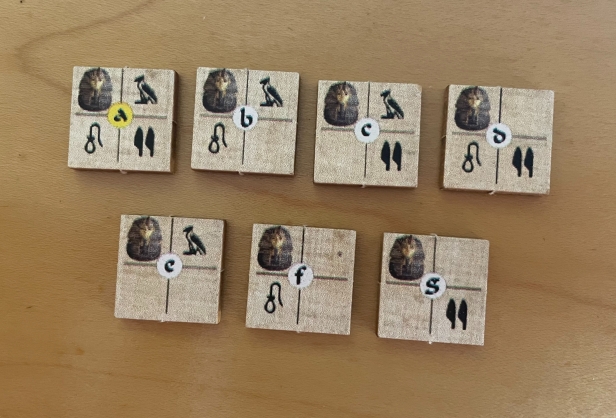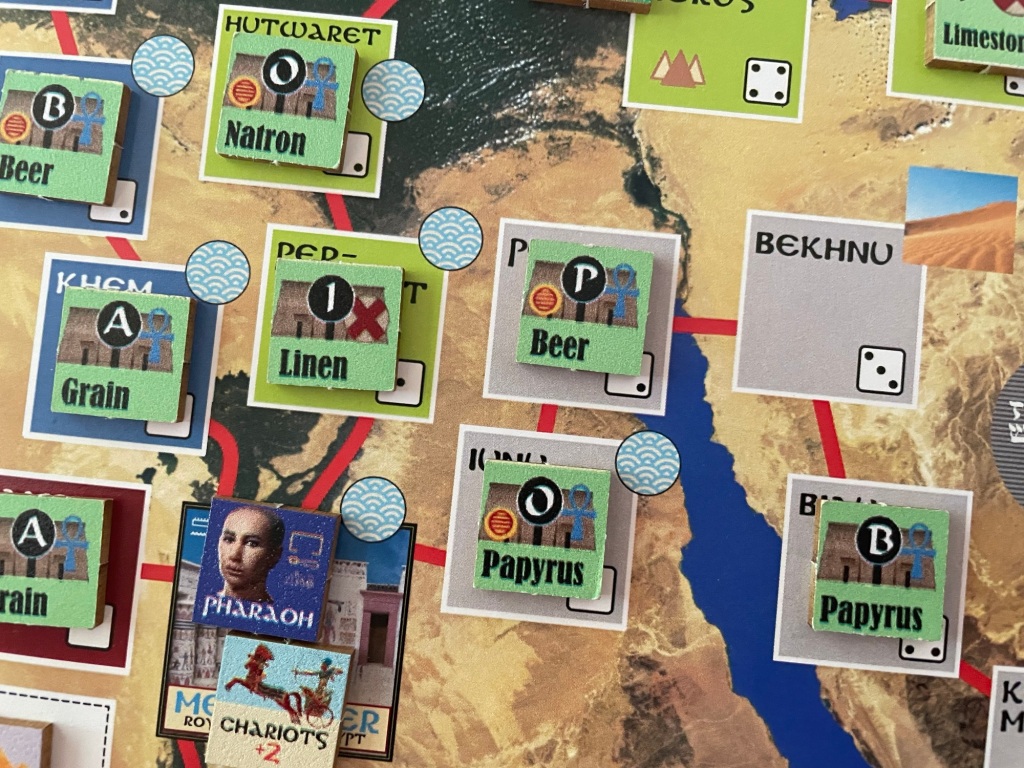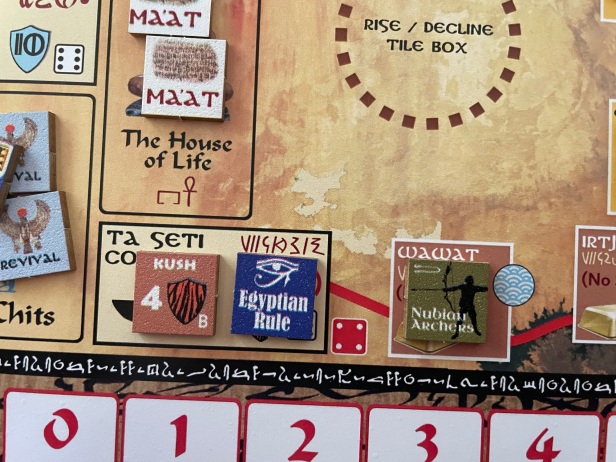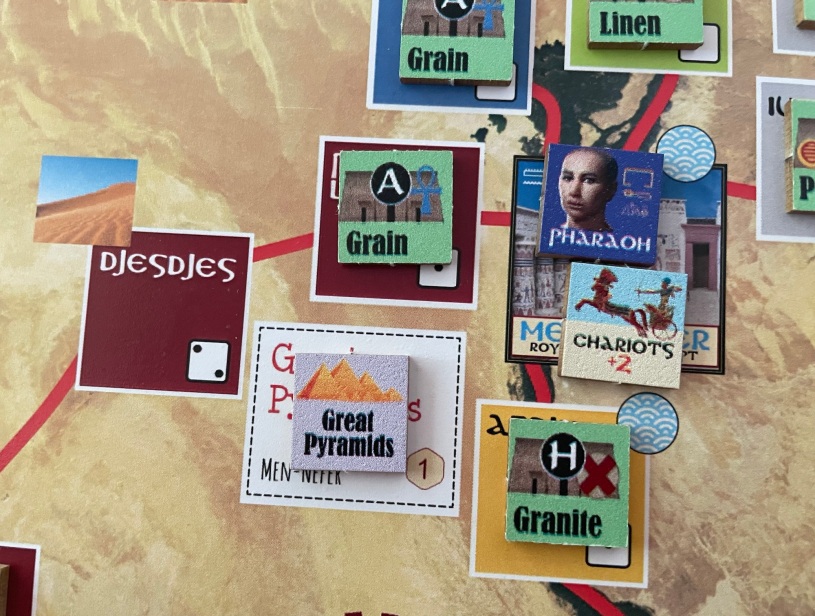I have really enjoyed my plays of several solitaire games designed by R. Ben Madison. He has a knack for including elements of the history into the gameplay while placing the events into the framework of his chosen system, which is usually the States of Siege Series…but not necessarily always. His newest offering is called Gift of the Nile: The Rise & Fall of Ancient Egypt from White Dog Games and is a solitaire only game that uses the States of Siege Series System and delves into Ancient Egypt and the rule of the Pharaohs covering over 30 dynasties starting with the Old Kingdom in 2600 BC to the Late Period starting in 700 BC and ending with the intervention of Rome. This is a long and involved game (ranging from 36 turns to something less based on certain conditions happening or a player loss) that really gives the player a good feel for the might and power of the Egyptians, as well as the various threats and enemies they had to deal with to survive for nearly 3,000 years.
In Action Point 1, we looked at the Game Map (board), which shows the various “Paths” used by the assaulting outside Khasti Kingdoms converging on the capital city of Men-Nefer. In Action Point 2, we investigated the purpose and makeup of the 3 different draw cups, which is where the game action starts including the Dynasty Cup, God Cup and Sepat Cup. In Action Point 3, we took a look at the Nile Phase and further discussed the economy of the game. In Action Point 4, we dove into the 4 different Eras or Kingdoms that the player must traverse through safely to come out on top and some of their unique aspects. In Action Point 5, we looked at the various Actions that players can take during the Action Phase and why they are important. In this Action Point, which is the conclusion to the series, we will discuss a few strategy pointers on how to do well at the game.
Strategy Points
Before we get too far into this one, the first point that I wish to make is that I don’t consider myself an amazing tactician. In fact, I struggle at games the same as everyone. But I do believe that all games can be a bit more enjoyed if you follow some basics of strategy. There are always things that the players should be focused on and remember as they play that will help guide their decisions and give them a greater chance at victory. These points that I am sharing for Gift of the Nile: The Rise & Fall of Ancient Egypt are such guiding principles.
Getting Off to a Good Start
At the start of the game, it feels like you are using training wheels. There really is no resistance to your and your expansion as there are no Khasti Armies pressing on your borders and only weak and underdeveloped Chiefdoms called Sepats that lie in your path to greatness. This is the time to get out hot and heavy! You have to push and expand your empire as much as possible. Remember, that when the Old Kingdom period ends, and the Middle Kingdom begins, your competing nations around Egypt will awaken and begin to move down the various Paths to attempt to stop your progress. Also, expansion is important because of the way the player will earn extra Action Points. As the player expands and builds their kingdom during the Old Kingdom, they conquer or incorporate established Sepats (chiefdoms) into their fledgling empire. As the empire expands, if you happen to have 2 different Sepats with the same Trade Good, you can count that as having that Trade Good to build your economy during the Nile Phase as it will earn an Action Point from the Trade Goods List if the dice say you will. These Sepats each have a different type of Trade Good that they are good at procuring and once that Sepat has become a part of your empire the player can Temple it (spend Action Points to build a temple in the area) and it will be more valuable as it will create a Trade Good on its own without having to rely on having two of that Trade Good to create an Action Point.

The Old Kingdom is about expanding your empire’s reach into the various lands located on the Tracks surrounding Men-Nefer so you can earn more Action Points in order to take more Actions each turn to build your empire including things such as building Monuments, attacking interloping civilizations called Khastis who have wandered into your kingdom, hiring mercenaries and troops to aid you in this fight and improving the education and literacy of your people. Each of these different Actions are important and the player must make many decisions about how to spend their scarce resources over the course of the game to build and expand. But the time is now and you have to get out and expand. This means that you should at a minimum conquer and control at least 3 Land Boxes on each Path, with 4 being even that much better. This will give you access to more goods, which will increase your number of Action Points each round. Sometimes players forget what the game is about and will begin dabbling in too many things too early (like Literacy or the construction of Megaprojects) and will ignore the good times for what they are – gobbling up your competition so they work for you!
Get the Gold – Secure the Ta Seti Path ASAP
The key to the game is obtaining as many Action Points as you possibly can each round. Most of your Action Points will come through the Nile Phase with the roll of 2D6 and the subtracting the higher number from the lower number to generate 1-5 AP’s but also through your Trade Goods that can also give you 1-5 AP’s But, one other source of income is Gold as the player can obtain Gold to use to build their economy by controlling 2 Land Boxes on the Ta Seti Path. These Land Boxes are Irtjet and Wawat located at the end of the Ta Seti Path adjacent to the Ta Seti Country Box. These boxes are located in Nubia and represent the vast gold deposits and mines in this country. If you notice on the Game Map, there is a note that these 2 Land Boxes cannot contain a Sepat but when the player has pushed the Khasti Army Tile here back to the Ta Seti Country Box, they are considered to control them. Control of these Land Boxes will provide the player with 1 Gold per Land Box so there is the potential to gain 2 Gold each round. Gold can be used to pay various costs for building Heroes such as the Nubian Archers or the Mera Fleet and also repairing special troops such as the Chariots. But these gold resources can also be used as an Action Point. So, if you have done your work and control these gold fields, you will also gain an extra Gold or 2 each turn that can supplement what you gain from the Nile Die Roll and Trade Goods.

Prepare to Build the Megaprojects – Save AP’s to Purchase Revival Chits
There are 3 possible Megaprojects that the player can build on the board and Pharaoh must be used to complete this Action. These include the Pyramids, the Valley of the Kings and the Ipet-Isut Temple Complex. Each of these Megaprojects will cost 3 Action Points to build along with Pharaoh being available and then placed in the Unavailable Box and they must be built in order with the Pyramids first, followed by the Ipet-Isut Temple Complex and finally the Valley of the Kings. You also have to have control of the Land Boxes where the Ipet-Isut Temple Complex and the Valley of the Kings are built at the time of the projects so you must control Wast.

When each of the Megaprojects are built the player may also spend up to 2 additional Action Points to purchase up to 2 Revival Chits for 1 AP each for each project. If they don’t or cannot buy them at the time of the project’s completion, they will lose this chance. Remember that the Revival Chits can be used to revive the civilization in the turn after Men-Nefer has fallen to an invading Khasti Army. If you don’t have a Revival Chit at this point, the game will come to an early end. Also Revival Chits are worth 7 Survival Points at the end of the game so any good strategy will involve them in your holdings. I find that I have to plan this Action out a few rounds in advance to make sure I have the requisite AP’s, to not just build but to also purchase the Revival Chits, and that Pharaoh is available so plan. You cannot afford not to get all of these Revival Chits.
Protect Your Investment and Hire the Medjai Police
Once you obtain these valuable Revival Chits, you definitely want to protect them! Remember, Egypt was a land of great riches and many of those riches were hidden in ancient tombs, temples and other structures. There were many adventurers and grave robbers who would seek out these riches and attempt to steal them. This is where the Medjai Police come in handy. The player can spend 2 AP to build the Medjai Police unit and place it in the Revival Chits Box on the board. Any time that the Tomb Robbers event is rolled on the Chronicles of Manetho, the Medjai Police unit is a persistent guard against these attempts and can block their grave robbing. The player simply rolls a D6 and if a 6 is the result, the grave robbers succeed and take 1 of your Revival Chits and destroy the Medjai Police unit. It can be rebuilt by the player spending another 2 AP’s during their turn. Any other result means that the Police have foiled the grave robbers and you are safe. Make sure you purchase the Medjai Police either before of just after you obtain Revival Chits.

Asses Your Abilities/Dynastic Skills Prior to Starting Each Action Phase
The Dynastic Skills, including Military, Religious and Social, are very important to the player and making sure to tailor your actions for that turn to take advantage of their advantages is key to doing well in the game. Each of the Dynasty Chits have 1 or more of these Dynastic Skills and the better chits, lettered a-d have 2-3 in varying distributions while the e-g chits have just 1 such Dynastic Skill. As this Dynasty Chit draw is random, you will tend to get better chits more often than the poorer ones as there are a 4-3 distribution but sometimes your luck will just be bad and you will continue to draw the worse chits. The good news is that at the start of each new Turn, when the player has to draw from the Dynasty Cup, the Dynasty Chit that was last drawn and placed onto The Book of the Dead and into the current Dynasty Box will remain there until after you draw. If it was one of the worse Dynasty Chits, you will now have a better chance of drawing a good Dynasty Chit as your odds improve as there will be 4 good chits in the cup as compared to just 2 that are worse. Good luck though! This is something that you simply cannot control and just have to grin and bear it.
The Military Skill it will aid the player in battle as they attack the invading Khasti Armies or as they attempt to conquer and incorporate regional Sepats (kingdoms) into their empire. The Military Skill provides the player with one free attack during the Action Phase at no cost. Normally, an Attack Action costs 1 Action Point but with the Military Skill you can perform one for free. One other note, during the Old Kingdom period, this free attack can be used to move the Medjai Troops into an adjacent Desert Land where there will be no Sepat to attack. But moving there for free makes it so you can use an Action to attack into the next adjacent Land Box later in that turn.

The Religious Skill allows the current Dynasty to Temple a Sepat for just 1 Action Point one time per turn. This action normally takes an amount of Action Points equal to the value listed on the Sepat Chit between 1-4. This benefit is huge as you will need to Temple Sepats in order to gain more access to Trade Goods and to get a defensive benefit when a Khasti Army moves into that Sepat. To Temple a Sepat, the player will simply pay the required AP’s and flip the Sepat Chit over to its Templed Side. Sepats which are Templed and Controlled at the end of the game will also provide the player with 1 Survival Point each. I always will use this skill to temple the most expensive available Sepat as it will save me from having to pay the whole cost.
Finally, the Social Skill is a nice skill to have because it simply grants the player one free Action Point that turn. The key here is that there is a limit of 9 earned AP’s per turn so you may get this but sometimes you are in a time of plenty and don’t have room in the Granary to hold an extra Action Point. This is collected during the Action Phase. But during the lean times, this can be a god send for you as an extra Action Point is never a bad thing, particularly if you rolled poorly or have lost several of your Templed Sepats and are no longer getting the Action Points associated with the Trade Goods.
These 3 Dynastic Skills are a very interesting part of the game and attempts to take into account the differences between various historical Pharaoh’s and their skill sets. I really how it fits into the game design and the administration and execution of this cup is the simplest and most straightforward of the 3 Draw Cups. But don’t underestimate the value of planning your moves out a bit based on utilizing these skills.
Temple Those Sepats
One of the most important and key Actions in the game is that of Templing Sepats. As the player expands their empire and discovers rival dynasties and small kingdoms, in order for the Egyptians to gain benefit from these discoveries, they will have to conquer these lands and establish their rule through the development of infrastructure to encourage the movement and trade of valuable commodities such as Beer, Copper, Grain, Granite, Limestone, Linen, Natron, Papyrus and Turquoise. A Templed Sepat also will defend itself from the invasions of Khasti Armies whereas an undeveloped Sepat will not. This is where Templing Sepats come into play.
To Temple a Sepat, the player will spend a number of AP’s equal to the Sepat’s current face-up value and then flip that Sepat over to its improved Templed side. There is no die roll involved but this can be costly as more rare Trade Good producing Sepats, such as Granite, Turquoise and Natron will typically be valued at 3 or 4 and will cost 3 or 4 AP’s.

I want to stress that it is important to be frugal and efficient with this Action. The player has got to pay attention to several different factors to maximize their return with the Templing Sepats Action. The first point is to do this Action on Paths that are currently in Decline due to a Decline Tile having been placed on that Path during the God Phase. This will reduce the cost to Temple a Sepat by -1 AP.

The second is to be aware of what Dynastic Skills the player currently has access to when the Dynasty Chit is placed out at the beginning of the round. If they have the Religious Skill this means that the current Dynasty can Temple a Sepat for just 1 Action Point one time per turn. Remember, this action normally takes an amount of Action Points equal to the value listed on the Sepat Chit between 1-4. You can also utilize Pharaoh to Temple a Sepat during the Old Kingdom Era for just 1 AP but this benefit will go away at the end of that Era.
Rely on Your Heroes
There are 2 different Hero units that the player can build in the game. These units represent the Nubian Archers and Mera Fleet and are elite military units that can be moved around the board to attack Khasti Armies and defend against their attacks. These heroes can only be built with the expenditure of Gold and there are typically some other conditions that must have been met. The Nubian Archers will cost 2 Gold to build while the Mera Fleet costs 4 Gold (2 Gold if the player controls Sheruhen on the Retjenu Path, which is Land Box 5 with the Tree Icon) and only after Dynasty 18 is complete. These Heroes can be moved out of the Heroes Box for 1 Action Point and do a number of things such as directly attack a Khasti Army at a +1 DRM, be placed defensively in a Land Box where if a Khasti Army moves in they get a free Attack (without the +1 DRM) or can be Reaction Moved from any space on the board to respond to a Khasti Army movement or Rival Dynasty Tile being placed at the cost of 2 Gold (or even 4 Gold to move to Men-Nefer to be the last line of defense).
Heroes are a vital part of any solid defensive plan and are best used in that defensive role as you only have to spend the Action Points to get the units where you want them and then they lay in wait to defend against an incursion. Doing the other Actions is very costly but it is nice to have them as an option when things are dire but

Stay Out of Debt
Good advice for life in general but in Gift of the Nile a must! Being in debt to the Romans can simply be disastrous. The more debt you have the more times they will activate to attack you late in the game and if you have more than 2-3 Debt you will simply not be able to stand up to them as they will march down that Path to Men-Nefer and overwhelm you. No matter the situation, no matter the siren call of “free” Action Points through borrowing from the Romans, you cannot go into debt. If you do, you have to understand what your limit is and stop there. I would never encourage anyone to go over 2 debt as you can hold against that but not against anymore than that. You will thank me later for my advice for restraint.
Well there you have it, 8 points of strategy. Keep in mind that I am by no means an expert at this game and have lost way more than I have won. But if the player keeps these simple tips and strategies in mind when playing, you will find that you are more successful than if not planning and abiding by these guidelines. I really have enjoyed playing Gift of the Nile and have come to truly appreciate the design and its simple yet interesting mechanics. This is a very good solitaire wargame and I cannot wait to see where Ben takes this system next.
-Grant
